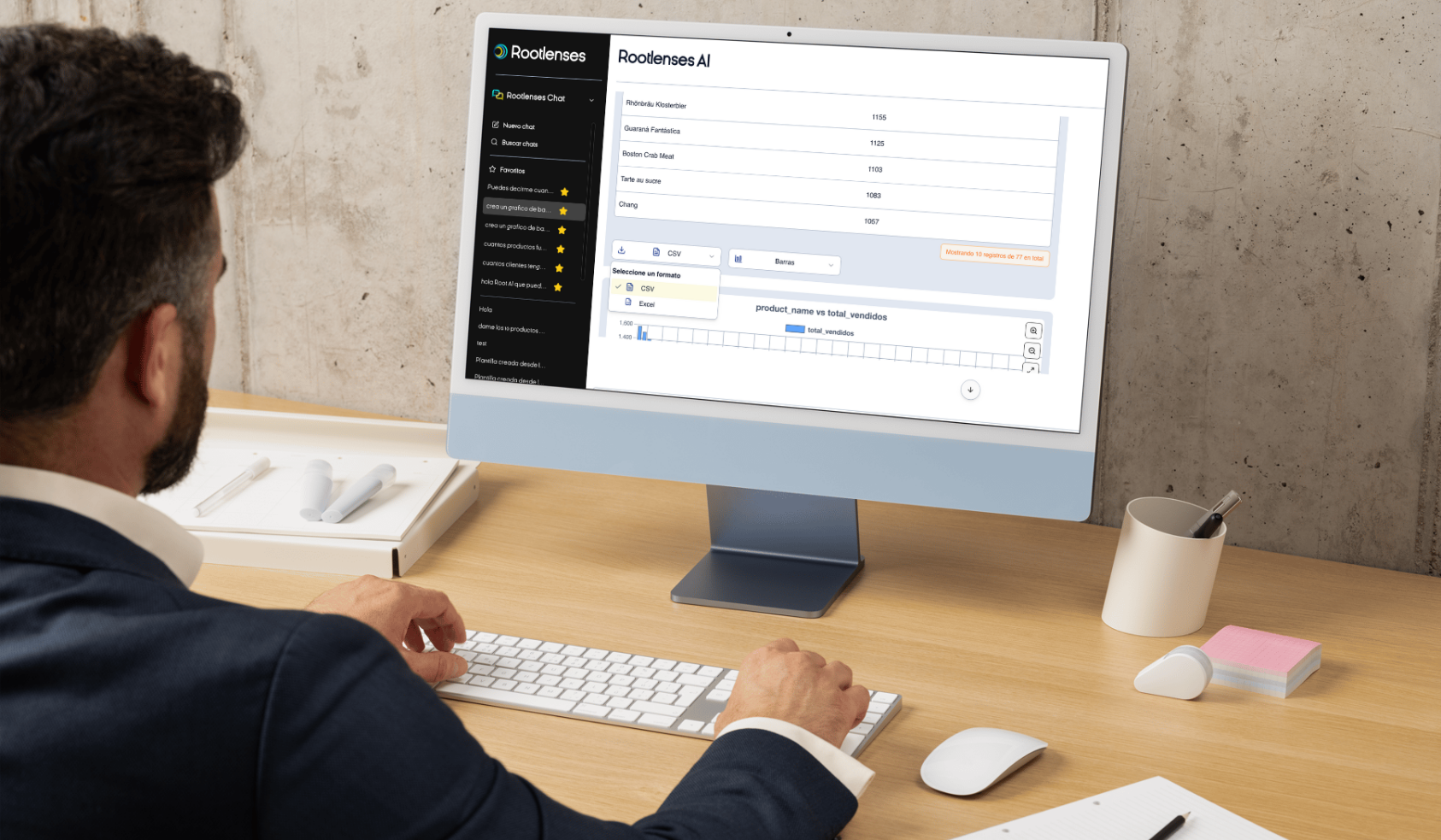Businesses are generating more data than ever, and having a tool capable of analyzing it quickly, accurately, and securely makes the difference between reacting or anticipating. Leaders are no longer just looking to visualize information: they need to understand it, interpret it, and turn it into smart decisions.
That's where Rootlenses Insight becomes a strategic ally. This AI-powered platform transforms the way teams access, explore, and report on their data.
It connects directly to information sources, understands their structure, and generates automated reports with governance, security, and business context, without relying on manual processes or advanced technical knowledge.
Unlike generic conversational models, such as ChatGPT, designed primarily to process natural language, Rootlenses Insight is built from the ground up as enterprise data analytics software. Its architecture is designed to integrate with real databases, deliver accurate answers, and ensure that each query meets the highest security and traceability standards.
In this article, we'll explore how Rootlenses Insight works, why it overcomes ChatGPT's limitations when analyzing data, and how it can help your organization turn information into its most valuable asset.
How can Rootlenses Insight analyze your data that ChatGPT can't?
1. Architecture and connectivity: direct and secure access to data sources
Rootlenses Insight connects to enterprise databases (MySQL, PostgreSQL, SQL Server, Oracle, etc.) using secure connectors. These connections enable:
- Authentication and authorization with encrypted credentials.
- Role-controlled access and data segmentation by permissions.
- Real-time queries on production data without the need to manually export it.
This native connector approach is critical for any data analytics tool that needs to operate in enterprise environments with compliance and privacy.
In contrast, ChatGPT in its basic form does not automatically connect to your corporate database from the public interface; accessing private data requires additional layers (plugins, custom integrations, or an intermediate API that acts as a proxy), which adds complexity and operational risks if not designed with strong controls in place. ChatGPT's integrations with external data typically come via custom-developed plugins or components.

2. Automatic schema exploration and data contextualization
Rootlenses Insight performs an automatic exploration of the schema (tables, types, relationships, data samples) to build context around database objects. With that context, the system:
- Label columns (dates, amounts, IDs, categories).
- Detects primary/foreign keys and relationships between tables.
- Calculates basic statistics (nulls, ranges, distributions) to guide queries.
Thanks to this stage, when a user asks a question in natural language, Rootlenses Insight transforms the intent into precise queries and generates coherent visual reports without manual intervention.
ChatGPT can parse files (e.g., CSV or Excel files you upload) using its advanced parsing feature, but it depends on whether the data is provided as files or text; it doesn't automatically scan the schema of a connected database or apply native governance controls over queries.s in production without additional integration.

3. Processing and Reporting Pipeline (How Rootlenses Insight Works)
- Secure Connection: The connector establishes TLS and encrypts credentials; Access is restricted by roles.
- Exploration and Sampling: The engine extracts metadata and samples to understand structures.
- Normalization: Minimal cleaning (column types, date formats) to avoid interpretation errors.
- Semantic Mapping: The system associates column names with meanings (e.g., “amount,” “sales_date,” “customer_id”).
- Optimized Query Generation: Natural language questions are translated into native SQL queries or pipelines.
- Visualization and Export: The result appears as tables and interactive charts and can be exported to CSV/XLS/JPG/PNG.
- Suggestions and Automation: Rootlenses Insight offers derived metrics, alerts, and automated periodic reports.
This pipeline is the type of flow required by teams that need automated and reproducible reports.
4. Governance, Security, and Compliance
Rootlenses Insight is designed for enterprise environments: audit logging, role-based access control, encryption in transit and at rest, and options for the organization to maintain data ownership. This allows for compliance with internal policies and regulatory requirements when using data analytics tools.
In the case of ChatGPT, OpenAI offers enterprise options and privacy controls (e.g., ChatGPT Enterprise), but the implications of sending data to external services and the need to design retention and integration policies are factors that each company should carefully evaluate. Additionally, secure connectivity and practical governance at the level of SQL queries in production often require additional architecture when using general conversational assistants.
5. Accuracy, Reproducibility, and Auditability
When you automate reports with Rootlenses Insight, every query, transformation, and visualization is logged and reproducible. This means that if someone questions a number in the report, you can trace exactly how it was obtained. For finance, auditing, and strategic decision-making, this traceability is essential.
With ChatGPT, if you work with uploaded files or prompts that generate queries, reproducibility depends on how those prompts are documented and managed and whether a versioning system exists; this typically requires additional work.
6. User Experience: Natural Language + Business-Ready Visualizations
Rootlenses Insight combines a conversational interface (natural language question-and-answer) with instant visualizations and export options. The goal is for any user, analyst or not, to be able to generate AI-powered reports without programming.
ChatGPT can help build exploratory analyses, write SQL, or process files with its advanced analysis mode, but to turn that interaction into productive, integrated, and governed data analysis software, additional layers (pipelines, access control, visualization engine) need to be developed.
Conclusion: ChatGPT or Rootlenses Insight?
For data analysis in productive environments, with direct database connectivity, governance, traceability, and automated reporting, Rootlenses Insight offers a complete solution specifically designed for that purpose.purpose.
Want to see it for yourself?
